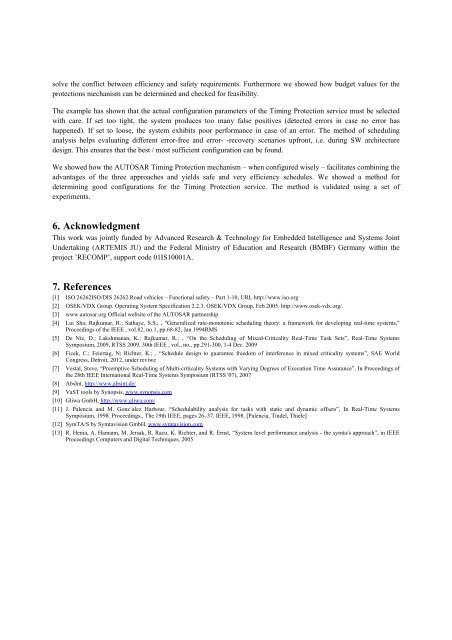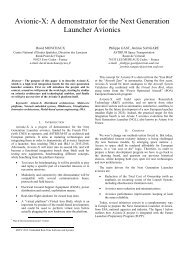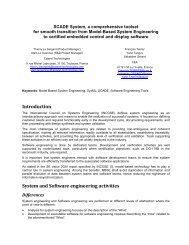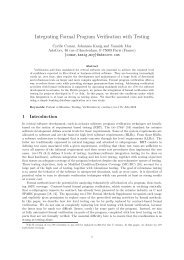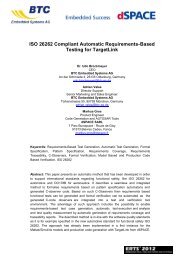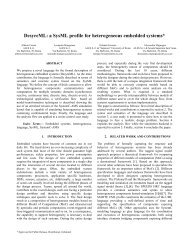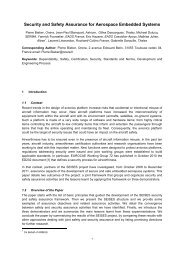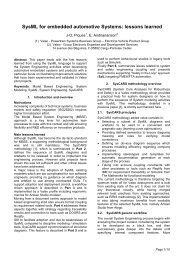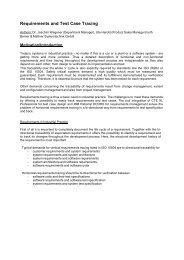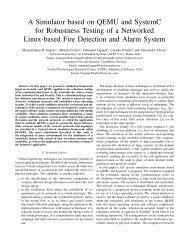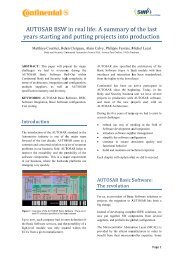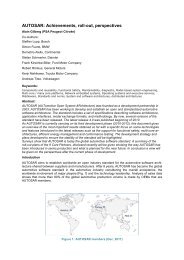Applying the AUTOSAR timing protection to build safe and efficient ...
Applying the AUTOSAR timing protection to build safe and efficient ...
Applying the AUTOSAR timing protection to build safe and efficient ...
Create successful ePaper yourself
Turn your PDF publications into a flip-book with our unique Google optimized e-Paper software.
solve <strong>the</strong> conflict between efficiency <strong>and</strong> <strong>safe</strong>ty requirements. Fur<strong>the</strong>rmore we showed how budget values for <strong>the</strong><br />
<strong>protection</strong>s mechanism can be determined <strong>and</strong> checked for feasibility.<br />
The example has shown that <strong>the</strong> actual configuration parameters of <strong>the</strong> Timing Protection service must be selected<br />
with care. If set <strong>to</strong>o tight, <strong>the</strong> system produces <strong>to</strong>o many false positives (detected errors in case no error has<br />
happened). If set <strong>to</strong> loose, <strong>the</strong> system exhibits poor performance in case of an error. The method of scheduling<br />
analysis helps evaluating different error-free <strong>and</strong> error- -recovery scenarios upfront, i.e. during SW architecture<br />
design. This ensures that <strong>the</strong> best / most sufficient configuration can be found.<br />
We showed how <strong>the</strong> <strong>AUTOSAR</strong> Timing Protection mechanism – when configured wisely – facilitates combining <strong>the</strong><br />
advantages of <strong>the</strong> three approaches <strong>and</strong> yields <strong>safe</strong> <strong>and</strong> very efficiency schedules. We showed a method for<br />
determining good configurations for <strong>the</strong> Timing Protection service. The method is validated using a set of<br />
experiments.<br />
6. Acknowledgment<br />
This work was jointly funded by Advanced Research & Technology for Embedded Intelligence <strong>and</strong> Systems Joint<br />
Undertaking (ARTEMIS JU) <strong>and</strong> <strong>the</strong> Federal Ministry of Education <strong>and</strong> Research (BMBF) Germany within <strong>the</strong><br />
project ’RECOMP’, support code 01IS10001A.<br />
7. References<br />
[1] ISO 26262ISO/DIS 26262 Road vehicles – Functional <strong>safe</strong>ty – Part 1-10, URL http://www.iso.org<br />
[2] OSEK/VDX Group. Operating System Specification 2.2.3. OSEK/VDX Group, Feb.2005. http://www.osek-vdx.org/.<br />
[3] www.au<strong>to</strong>sar.org Official website of <strong>the</strong> <strong>AUTOSAR</strong> partnership<br />
[4] Lui Sha; Rajkumar, R.; Sathaye, S.S.; , "Generalized rate-mono<strong>to</strong>nic scheduling <strong>the</strong>ory: a framework for developing real-time systems,"<br />
Proceedings of <strong>the</strong> IEEE , vol.82, no.1, pp.68-82, Jan 1994RMS<br />
[5] De Niz, D.; Lakshmanan, K.; Rajkumar, R.; , “On <strong>the</strong> Scheduling of Mixed-Criticality Real-Time Task Sets”, Real-Time Systems<br />
Symposium, 2009, RTSS 2009. 30th IEEE , vol., no., pp.291-300, 1-4 Dec. 2009<br />
[6] Ficek, C.; Feiertag, N; Richter, K.; , “Schedule design <strong>to</strong> guarantee freedom of interference in mixed criticality systems”, SAE World<br />
Congress, Detroit, 2012, under reviwe<br />
[7] Vestal, Steve, “Preemptive Scheduling of Multi-criticality Systems with Varying Degrees of Execution Time Assurance”, In Proceedings of<br />
<strong>the</strong> 28th IEEE International Real-Time Systems Symposium (RTSS '07), 2007<br />
[8] AbsInt, http://www.absint.de/<br />
[9] VaST <strong>to</strong>ols by Synopsis, www.synopsis.com<br />
[10] Gliwa GmbH, http://www.gliwa.com/<br />
[11] J. Palencia <strong>and</strong> M. Gonz´alez Harbour, “Schedulability analysis for tasks with static <strong>and</strong> dynamic offsets”, In Real-Time Systems<br />
Symposium, 1998. Proceedings., The 19th IEEE, pages 26–37. IEEE, 1998. [Palencia, Tindel, Thiele]<br />
[12] SymTA/S by Symtavision GmbH, www.symtavision.com<br />
[13] R. Henia, A. Hamann, M. Jersak, R. Racu, K. Richter, <strong>and</strong> R. Ernst, “System level performance analysis - <strong>the</strong> symta/s approach”, in IEEE<br />
Proceedings Computers <strong>and</strong> Digital Techniques, 2005


